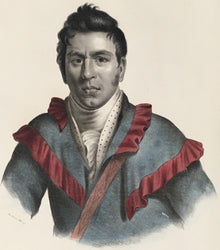Charles Bird King. “Ochio Fincio-Charles Cornels.” [Creek].
From McKenney & Hall History of the Native American Tribes of North America. Printed in Philadelphia, 1834-38. Publisher remainder. Originally published by E. C. Biddle, 1834. Folio. 10 ¾ x 9 ½ (image). 21 ¾ x 15 3/8 (paper). Lithograph by Lehman & Duval. With original hand coloring on jacket. Face is uncolored. Very good condition.
A print intended for McKenney & Hall’s impressive portfolio of Native American portraits. These prints document an important part of American History, the great leaders of the aboriginal cultures that have disappeared since the mid-nineteenth century. Thomas McKenney, head of the United States Bureau of Indian Affairs for many years, was a champion of the Native Americans and fought throughout his tenure to preserve something of their culture, so integral a part of the history of the United States. His legacy was a gallery of portraits of the great chiefs by artists such as James Otto Lewis, and Charles Bird King.
The results of years of struggle, McKenney’s portfolio was finished in 1844, when completed consisting of 117 portraits and three frontispieces. Although he was acutely aware that he was preserving a chapter in history, he could not have known that had he not undertaken this project almost no record would remain, for in 1865 a fire at the Smithsonian destroyed almost all the original paintings from which the lithographs were drawn. This print is one that remained since the nineteenth century in one of the publisher’s warehouses, having been only partially colored and never issued. Thus the excellent condition is explained by the print never having been subjected to the vicissitudes of the open market, and the chance survival for over a century and a half is most fortuitous.

![King, Charles Bird “Ochio Fincio-Charles Cornels” [Creek]](http://philaprintshop.com/cdn/shop/files/ochiofolionofacethmb_{width}x.jpg?v=1743616230)
![King, Charles Bird “Ochio Fincio-Charles Cornels” [Creek]](http://philaprintshop.com/cdn/shop/files/ochiofolionoface_{width}x.jpg?v=1743616238)
![Load image into Gallery viewer, King, Charles Bird “Ochio Fincio-Charles Cornels” [Creek]](http://philaprintshop.com/cdn/shop/files/ochiofolionofacethmb_110x110@2x.jpg?v=1743616230)
![Load image into Gallery viewer, King, Charles Bird “Ochio Fincio-Charles Cornels” [Creek]](http://philaprintshop.com/cdn/shop/files/ochiofolionoface_110x110@2x.jpg?v=1743616238)
